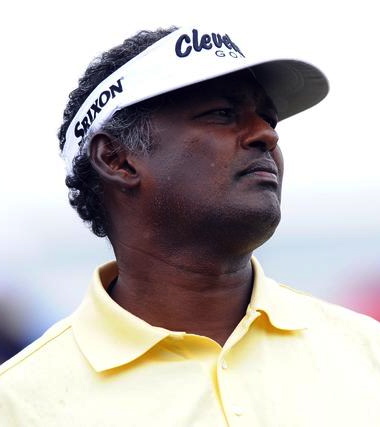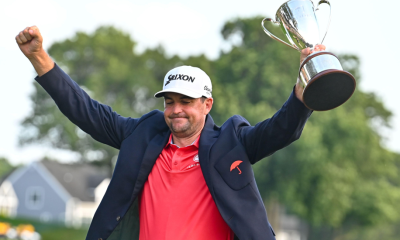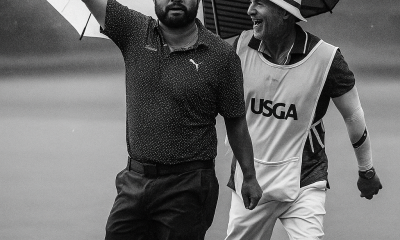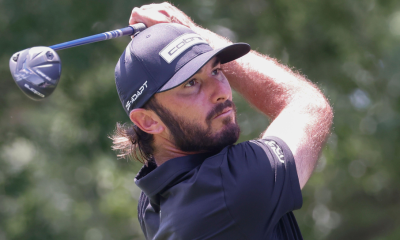Opinion & Analysis
Singh: Ruthless and immoral, or simply careless?

Vijay Singh should be remembered as one of golf’s most successful late bloomers, with 22 of his 34 PGA Tour wins taking place in the decade since he turned the big four-oh. He should be honored for his 26 second-place finishes, 17 third-place finishes and the more than $67 million he’s earned on Tour. He should also get a place next to Ben Hogan on the Mount Rushmore of golf as one of the all-time range warriors.
Instead, the last lines of his legacy may end up reading the same as his early entries: cheater.
A recent Sports Illustrated story exposed a small sports supplement company that had been marketing a spray containing IGF-1, a growth hormone-like substance that is banned by every major sports league, including the Tour. The story named several prominent athletes as clients, including Singh. Like most of the athletes who are caught using, he claimed that he did not know the product, which is derived from deer antlers, contained a banned substance. To his credit, Singh has admitted his use of the product and is complying with Tour officials as they investigate they situation.
“I am absolutely shocked that deer-antler spray may contain a banned substance and am angry that I have put myself in this position. I have been in contact with the PGA Tour and am cooperating fully with their review of this matter. I will not be commenting further at this time,” said Singh in a written statement.
Tour officials will want to know how long he has been using the product and what else he may have been using before determining what action to take — including a possible suspension, a decision that could ultimately cost Singh millions in endorsements and prize money. In the meantime, Singh has withdrawn from the latest Tour stop, the Waste Management Phoenix Open in Scottsdale, Ariz.
It’s not a stretch to say that Singh is one of the least popular players on the Tour, so it’s no surprise that he isn’t getting much support from his peers.
‘‘It’s sad that people live and die by their sport and they have to, I guess, cheat and go around it and try to better themselves with deer-antler spray,’’ Bubba Watson told reporters in Scottsdale. ‘‘I’m not just going to take something and ask questions later. I’m not going to take deer-antler spray and find out what it is later. I think we should check them for mental problems if they’re taking deer-antler spray. That’s kind of weird.’’
Tour veteran Mark O’Meara went on record calling for Singh to be suspended.
“Probably he should be suspended for a couple of months, and I don’t know what the PGA Tour Commissioner is thinking, but people have had to pay the price before and he should be no different,” O’Meara told reporters.
Like Tiger Woods, Singh doesn’t have an easy smile or a “aw shucks” way of talking to the press or the fans. On the contrary, he seems to go out of his way to alienate, aggravate or intimidate anyone around him that he doesn’t feel the necessity to connect to, which is barely anyone. Once after a practice session, I asked him if I could get five seconds for a couple of questions. He looked me over, raised and eyebrow and said, “I’ll give you three.”
A lifetime of being crunchy and obtuse leaves Singh ill-equipped for the public relations storm that he will have to navigate over the coming months or even years. Through his many accomplishments, Singh had managed to bury the stigma of allegations of improving his lie and altering his scorecard while on the Asian Tour during the 80s. He also managed to distance himself from the disparaging remarks he made about Annika Sorenstam’s historic appearance on the men’s tour.
But this time, it will be harder to avoid a lasting scar. Singh finds himself now categorized in a group that includes Lance Armstrong, Barry Bonds, Sammy Sosa, Roger Clemens and Alex Rodriguez. They’re all considered cheaters, guys who would do anything to obtain and maintain excellence. They all have stellar career records that are now regarded as counterfeit, even the portion of their achievements that came before they began using PEDs.
Bubba Watson has a point; you’d have to be almost crazy to check for the banned ingredients and not see them on the list. I found the ingredient in just a casual search of the Tour drug policy guide. It leads the skeptic to think three things.
- Singh believed that he was getting a product that would help his aging body stay young.
- He had faith that the product would achieve that because it contained a substance that is banned precisely because it did just that.
- Like every other steroid peddler, the deer antler spray guys likely told Singh that it was untraceable. It seems like a hard line to take, but that has been the path that virtually every other performance enhancing drug case in every other sport has taken.
The PGA Tour is probably as ill-equipped for this situation as Singh. While they do in fact have a detailed policy, they have little practical experience with how to handle a positive test or an admission of guilt like Singh’s. Indeed, since testing began in 2008, only one player, Doug Barron, has tested positive and subsequently been suspended.
Tour Commissioner Tim Finchem would be well served to give MLB Commissioner Bud Selig a call. Selig knows all too well the perils along this path. As the guardian of his sport, Finchem may be tempted to gloss over, minimize or even cover up elements of the story out of a desire to keep the sport out of the negative spotlight. Such actions proved folly for baseball. When every owner and every player knew there was a problem in the sport, instead of confronting the issue they chose collective silence as a course of action. It proved to be a disastrous decision, rendering a generation of its greatest stars irrelevant to the overarching history of the game.
As the Tour determines what to do in the case of Singh, officials should keep in mind that baseball and golf are similar in that their histories are just as important as their present. The ability to draw a line of comparison from Tom Morris to Tom Watson to Bubba Watson is essential to the appreciation of the ancient game. While most have come to grips with the effect that equipment technology has had on the game, there will likely be no tolerance for game improvement via illegal supplements.
For Vijay Singh, the coming days will determine whether he will be perceived as ruthless and immoral, or simply careless and gullible. For the sport, the challenge will be to respond to this incident in a way that prevents an isolated spot from becoming a lasting stain.
Opinion & Analysis
The 2 primary challenges golf equipment companies face

As the editor-in-chief of this website and an observer of the GolfWRX forums and other online golf equipment discourse for over a decade, I’m pretty well attuned to the grunts and grumbles of a significant portion of the golf equipment purchasing spectrum. And before you accuse me of lording above all in some digital ivory tower, I’d like to offer that I worked at golf courses (public and private) for years prior to picking up my pen, so I’m well-versed in the non-degenerate golf equipment consumers out there. I touched (green)grass (retail)!
Complaints about the ills of and related to the OEMs usually follow some version of: Product cycles are too short for real innovation, tour equipment isn’t the same as retail (which is largely not true, by the way), too much is invested in marketing and not enough in R&D, top staffer X hasn’t even put the new driver in play, so it’s obviously not superior to the previous generation, prices are too high, and on and on.
Without digging into the merits of any of these claims, which I believe are mostly red herrings, I’d like to bring into view of our rangefinder what I believe to be the two primary difficulties golf equipment companies face.
One: As Terry Koehler, back when he was the CEO of Ben Hogan, told me at the time of the Ft Worth irons launch, if you can’t regularly hit the golf ball in a coin-sized area in the middle of the face, there’s not a ton that iron technology can do for you. Now, this is less true now with respect to irons than when he said it, and is less and less true by degrees as the clubs get larger (utilities, fairways, hybrids, drivers), but there remains a great deal of golf equipment truth in that statement. Think about it — which is to say, in TL;DR fashion, get lessons from a qualified instructor who will teach you about the fundamentals of repeatable impact and how the golf swing works, not just offer band-aid fixes. If you can’t repeatably deliver the golf club to the golf ball in something resembling the manner it was designed for, how can you expect to be getting the most out of the club — put another way, the maximum value from your investment?
Similarly, game improvement equipment can only improve your game if you game it. In other words, get fit for the clubs you ought to be playing rather than filling the bag with the ones you wish you could hit or used to be able to hit. Of course, don’t do this if you don’t care about performance and just want to hit a forged blade while playing off an 18 handicap. That’s absolutely fine. There were plenty of members in clubs back in the day playing Hogan Apex or Mizuno MP-32 irons who had no business doing so from a ballstriking standpoint, but they enjoyed their look, feel, and complementary qualities to their Gatsby hats and cashmere sweaters. Do what brings you a measure of joy in this maddening game.
Now, the second issue. This is not a plea for non-conforming equipment; rather, it is a statement of fact. USGA/R&A limits on every facet of golf equipment are detrimental to golf equipment manufacturers. Sure, you know this, but do you think about it as it applies to almost every element of equipment? A 500cc driver would be inherently more forgiving than a 460cc, as one with a COR measurement in excess of 0.83. 50-inch shafts. Box grooves. And on and on.
Would fewer regulations be objectively bad for the game? Would this erode its soul? Fortunately, that’s beside the point of this exercise, which is merely to point out the facts. The fact, in this case, is that equipment restrictions and regulations are the slaughterbench of an abundance of innovation in the golf equipment space. Is this for the best? Well, now I’ve asked the question twice and might as well give a partial response, I guess my answer to that would be, “It depends on what type of golf you’re playing and who you’re playing it with.”
For my part, I don’t mind embarrassing myself with vintage blades and persimmons chasing after the quasi-spiritual elevation of a well-struck shot, but that’s just me. Plenty of folks don’t give a damn if their grooves are conforming. Plenty of folks think the folks in Liberty Corner ought to add a prison to the museum for such offences. And those are just a few of the considerations for the amateur game — which doesn’t get inside the gallery ropes of the pro game…
Different strokes in the game of golf, in my humble opinion.
Anyway, I believe equipment company engineers are genuinely trying to build better equipment year over year. The marketing departments are trying to find ways to make this equipment appeal to the broadest segment of the golf market possible. All of this against (1) the backdrop of — at least for now — firm product cycles. And golfers who, with their ~15 average handicap (men), for the most part, are not striping the golf ball like Tiger in his prime and seem to have less and less time year over year to practice and improve. (2) Regulations that massively restrict what they’re able to do…
That’s the landscape as I see it and the real headwinds for golf equipment companies. No doubt, there’s more I haven’t considered, but I think the previous is a better — and better faith — point of departure when formulating any serious commentary on the golf equipment world than some of the more cynical and conspiratorial takes I hear.
Agree? Disagree? Think I’m worthy of an Adam Hadwin-esque security guard tackle? Let me know in the comments.
@golfoncbs The infamous Adam Hadwin tackle ? #golf #fyp #canada #pgatour #adamhadwin ? Ghibli-style nostalgic waltz – MaSssuguMusic
Podcasts
Fore Love of Golf: Introducing a new club concept

Episode #16 brings us Cliff McKinney. Cliff is the founder of Old Charlie Golf Club, a new club, and concept, to be built in the Florida panhandle. The model is quite interesting and aims to make great, private golf more affordable. We hope you enjoy the show!
Opinion & Analysis
On Scottie Scheffler wondering ‘What’s the point of winning?’

Last week, I came across a reel from BBC Sport on Instagram featuring Scottie Scheffler speaking to the media ahead of The Open at Royal Portrush. In it, he shared that he often wonders what the point is of wanting to win tournaments so badly — especially when he knows, deep down, that it doesn’t lead to a truly fulfilling life.
View this post on Instagram
“Is it great to be able to win tournaments and to accomplish the things I have in the game of golf? Yeah, it brings tears to my eyes just to think about it because I’ve literally worked my entire life to be good at this sport,” Scheffler said. “To have that kind of sense of accomplishment, I think, is a pretty cool feeling. To get to live out your dreams is very special, but at the end of the day, I’m not out here to inspire the next generation of golfers. I’m not out here to inspire someone to be the best player in the world, because what’s the point?”
Ironically — or perhaps perfectly — he went on to win the claret jug.
That question — what’s the point of winning? — cuts straight to the heart of the human journey.
As someone who’s spent over two decades in the trenches of professional golf, and in deep study of the mental, emotional, and spiritual dimensions of the game, I see Scottie’s inner conflict as a sign of soul evolution in motion.
I came to golf late. I wasn’t a junior standout or college All-American. At 27, I left a steady corporate job to see if I could be on the PGA Tour starting as a 14-handicap, average-length hitter. Over the years, my journey has been defined less by trophies and more by the relentless effort to navigate the deeply inequitable and gated system of professional golf — an effort that ultimately turned inward and helped me evolve as both a golfer and a person.
One perspective that helped me make sense of this inner dissonance around competition and our culture’s tendency to overvalue winning is the idea of soul evolution.
The University of Virginia’s Division of Perceptual Studies has done extensive research on reincarnation, and Netflix’s Surviving Death (Episode 6) explores the topic, too. Whether you take it literally or metaphorically, the idea that we’re on a long arc of growth — from beginner to sage elder — offers a profound perspective.
If you accept the premise literally, then terms like “young soul” and “old soul” start to hold meaning. However, even if we set the word “soul” aside, it’s easy to see that different levels of life experience produce different worldviews.
Newer souls — or people in earlier stages of their development — may be curious and kind but still lack discernment or depth. There is a naivety, and they don’t yet question as deeply, tending to see things in black and white, partly because certainty feels safer than confronting the unknown.
As we gain more experience, we begin to experiment. We test limits. We chase extreme external goals — sometimes at the expense of health, relationships, or inner peace — still operating from hunger, ambition, and the fragility of the ego.
It’s a necessary stage, but often a turbulent and unfulfilling one.
David Duval fell off the map after reaching World No. 1. Bubba Watson had his own “Is this it?” moment with his caddie, Ted Scott, after winning the Masters.
In Aaron Rodgers: Enigma, reflecting on his 2011 Super Bowl win, Rodgers said:
“Now I’ve accomplished the only thing that I really, really wanted to do in my life. Now what? I was like, ‘Did I aim at the wrong thing? Did I spend too much time thinking about stuff that ultimately doesn’t give you true happiness?’”
Jim Carrey once said, “I think everybody should get rich and famous and do everything they ever dreamed of so they can see that it’s not the answer.”
Eventually, though, something shifts.
We begin to see in shades of gray. Winning, dominating, accumulating—these pursuits lose their shine. The rewards feel more fleeting. Living in a constant state of fight-or-flight makes us feel alive, yes, but not happy and joyful.
Compassion begins to replace ambition. Love, presence, and gratitude become more fulfilling than status, profits, or trophies. We crave balance over burnout. Collaboration over competition. Meaning over metrics.
Interestingly, if we zoom out, we can apply this same model to nations and cultures. Countries, like people, have a collective “soul stage” made up of the individuals within them.
Take the United States, for example. I’d place it as a mid-level soul: highly competitive and deeply driven, but still learning emotional maturity. Still uncomfortable with nuance. Still believing that more is always better. Despite its global wins, the U.S. currently ranks just 23rd in happiness (as of 2025). You might liken it to a gifted teenager—bold, eager, and ambitious, but angsty and still figuring out how to live well and in balance. As much as a parent wants to protect their child, sometimes the child has to make their own mistakes to truly grow.
So when Scottie Scheffler wonders what the point of winning is, I don’t see someone losing strength.
I see someone evolving.
He’s beginning to look beyond the leaderboard. Beyond metrics of success that carry a lower vibration. And yet, in a poetic twist, Scheffler did go on to win The Open. But that only reinforces the point: even at the pinnacle, the question remains. And if more of us in the golf and sports world — and in U.S. culture at large — started asking similar questions, we might discover that the more meaningful trophy isn’t about accumulating or beating others at all costs.
It’s about awakening and evolving to something more than winning could ever promise.






















John Fugazzi
Mar 12, 2013 at 2:19 am
One sided, lop sided, and short sighted. Vijay Singh probably was an naive idiot for actually hearing and trying some herbal remedy. Shady players have personal shoppers who buy things like this for them to “give a try.”
Screamin'
Feb 6, 2013 at 1:03 pm
I seriously doubt that deer antler spray is the reason for his success after 40.
Red
Feb 6, 2013 at 11:35 am
Hell hath no fury like a woman scorned…always a nice catalyst for rip-job article
Anthony D'Cruz
Feb 5, 2013 at 8:52 am
It appears that Vijay is not very popular. Can you imagine what would have happened to him had he stolen a cm or two on the putting green and sank the putt for a win? What if he had declared it was an ‘honest mistake’? Would he have been let off? I’m afraid the poor man’s already been found guilty before the hearing.
Harbaugh
Feb 3, 2013 at 11:33 am
Bubba kicking a man while he is down and being applauded for it – what on earth???
Tony
Feb 3, 2013 at 10:49 am
I find this article fails in providing an objective view i.e. it is charged with bias. Leave your hurt feelings and opinions at the door if you claim to be a jouurnalist. Epic fail.
Eric Evans
Feb 2, 2013 at 10:15 am
This does not surprise me one bit about Vijay considering how much of an a$$ he is.
Troy Vayanos
Feb 1, 2013 at 10:52 pm
I couldn’t imagine Vijay Singh ever taking a banned substance to gain an advantage over his opponents. I’m still not sure how this would help in golf anyway.
The only substance that would benefit in golf would be beta-blockers which are banned anyway.
I’m be interested to follow this story and see how it turns out.
Mac
Feb 1, 2013 at 2:15 pm
its a bunch of b.s. when he says that he didnt know it contained the substance, he obviously knew that it would help with anti-aging to stay in the PGA for as long as he could, but to end like this? Terrible choice, v.j. terrible choice.
Bill's an idiot**
Feb 1, 2013 at 8:01 am
Too*
clay smith
Feb 1, 2013 at 7:58 am
Although the article nails him in his attitude and how people feel about him, (seen him up close at a tournament), why would he tell a national magazine reporter he was using it if he was hiding it? What’s funny is most of these (over the counter) products are bogus, make bogus claims, and don’t do what they say. Plecebo effect. I think he should be tested to see if he has any IGH-1 in his system, I bet he doesn’t, and then assess a punishment if necessary. Maybe a slap on the hand for not ‘checking’ on the ingredients.
Blanco
Feb 1, 2013 at 2:22 am
From what I know about the deer antler, it’s been used in the past by many a high-profile PGA tour player, all of whom are not mentioned in this article… there is also no discussion of what may have led Singh to use it. I also understand that it gives the body a larger dose of one of its naturally occurring chemicals that aids in recovery from injury (as opposed to something that provide a competitive advantage over healthy golfers), ala the Toradol injections used by hundreds of NFL players before every game… This is the extent of what I understand yet I realize there is more to it of course.
Just as the PGA goes out of its way to be vague and “obtuse” in dealing with rules violations, the author and GolfWRX continues to puzzle me with articles like this. I look to the front page for golf journalism, and the forums for opinion. Most of the writers on Golfwrx write in a journalistic manner and when opinion pieces are written, the “opinion” is clearly understood by reading the article’s title. “Singh: “R”uthless and immoral, or simply careless?” leads me to think I’ll hear at least two sides to this story.
Instead, I’ve just wasted two minutes on a purple anti-Vijay tabloid piece. If Williams considers himself a journalist, he has again compromised his integrity by revealing his personal distaste for Vijay (and Tiger Woods conveniently) and giving zero voice to the contrary of Mark O’Meara and Bubba Watson of which there is plenty. In fact, I’ve read a few articles published in respected news outlets where the “least popular player on the PGA tour” stigma has been accurately painted as a media-born concept and holds no weight in reality.
DH2
Feb 1, 2013 at 12:51 am
He is a selfish person who doesn’t care about others. I pulled some major strings for him and no gratitude was given back. I work for a major Hotel in Denver and called in a favor to a trainer at an exclusive athletic club. Vijay got to have the weight room to himself for half an hour each day for a week. Vijay and his trainer did not thank me or give me a gratuity for my efforts. I hope the tour suspends him.
Gibby
Jan 31, 2013 at 7:58 pm
Once a cheater, always a cheater. Remember the hat he wore that said “Tiger Who”
Well soon it will be “Vijay Who” He will always be remembered as a cheater who treated everyone around him like crap!
LBW
Jan 31, 2013 at 7:27 pm
VIJAY IS AND ALWAYS HAS BEEN A PERSON THAT PUSHES THE RULES TO THE POINT OF CHEATING
MaxW
Jan 31, 2013 at 5:24 pm
Vijay strikes me as an intelligent guy; irascible and a curmudgeon, and definitely not careless and gullible. He knows you play the game of golf by the rules. He knows there are banned substances. He knows one phone call to the PGA tour would determine if the product and/or substance was banned or not. Just like on the course he can ask a rules official about a rules situation or not. He did not ask the Tour about the product/substance and now he should pay the penalty.
naflack
Jan 31, 2013 at 4:56 pm
It doesn’t surprise me considering who his trainer is…